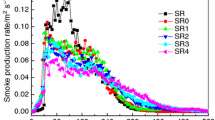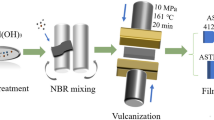Abstract
The main aim of this work was to investigate the synergistic effect of expandable graphite (EG) and aluminum hypophosphite (AHP) on the flame retardancy of silicone rubbers (SR). The synergistic effects of EG with AHP in halogen-free flame-retardant SR composites have been studied by cone calorimeter test (CCT), thermogravimetric analysis (TG), and the thermogravimetric analysis/infrared spectrometry (TG–IR). The CCT results showed that AHP and EG can effectively reduce the flammable properties including peak heat release rate, total heat release, smoke production rate, total smoke release, and smoke factor. An improvement of thermal stability of SR/AHP/EG was also observed. The experimental observations from digital photographs give positive evidence of the synergistic effects between AHP with EG. The TG results reveal that SR/AHP/EG samples show slower thermal degradation rate and higher thermal stability at high temperature than SR sample. The TG–IR results showed that the addition of AHP and EG significantly decreased the combustible gaseous products such as hydrocarbons. These attractive features of SR/AHP/EG suggest that the method proposed herein is a good approach to prepare very effective flame retardants and corresponding super flame-retarding SR.














Similar content being viewed by others
References
Jana R, Nando G, Khastgir D. Compatibilised blends of LDPE and PDMS rubber as effective cable insulants. Plast, Rubber Compos. 2003;32:1.
Wang J, Chen Y, Jin Q. Preparation and characteristics of a novel silicone rubber nanocomposite based on organophilic montmorillonite. High Perform Polym. 2006;18:325–40.
Chiu H, Wu J. Conductive effect of an electronic/ionic complex conductivity modifier for silicone elastomers. J Mater Sci. 2005;97:711–20.
Janowska G, Kucharska-Jastrza˛bek A, Rybin´ski P. Thermal stability, flammability and fire hazard of butadiene–acrylonitrile rubber nanocomposites. J Therm Anal Calorim. 2011;103:1039–46.
Chen XL, Jiao CM, Zhang J. Microencapsulation of ammonium polyphosphate with hydroxyl silicone oil and its flame retardance in thermoplastic polyurethane. J Therm Anal Calorim. 2011;104:1037–43.
Chen L, Wang Y. A review on flame retardant technology in China. Part I: development of flame retardants. Polym Adv Technol. 2009;21:1–26.
Covaci A, Harrad S, Abdallah MAE, Ali N, Law RJ, Herzke D, Wit C. Novel brominated flame retardants: a review of their analysis, environmental fate and behaviour. Environ Int. 2011;37:532–56.
Duquesne S, Bras M, Bourbigot S, Delobel R, Vezin H, Camino G, Eling B, Lindsay C, Roels T. Expandable graphite: a fire retardant additive for polyurethane coatings. Fire Mater. 2003;27:103–17.
Modesti M, Lorenzetti A, Simioni F, Camino G. Expandable graphite as an intumescent flame retardant in polyisocyanurate–polyurethane foams. Polym Degrad Stab. 2002;77(2):195–202.
Xie R, Qu B. Thermo-oxidative degradation behaviors of expandable graphite-based intumescent halogen-free flame retardant LLDPE blends. Polym Degrad Stab. 2001;71:395–402.
Duquesne S, Delobel R, Bras M, Camino G. A comparative study of the mechanism of action of ammonium polyphosphate and expandable graphite in polyurethane. Polym Degrad Stab. 2002;77(2):333–44.
Meng X, Ye L, Zhang X, Tang P, Tang J, Ji X, Li Z. Effects of expandable graphite and ammonium polyphosphate on the flame-retardant and mechanical properties of rigid polyurethane foams. J Appl Polym Sci. 2009;114(2):853–63.
Xu Y, Chen M, Ning X. Influences of coupling agent on thermal properties, flammability and mechanical properties of polypropylene/thermoplastic polyurethanes composites filled with expanded graphite. J Therm Anal Calorim. 2014;115:689–95.
Yang W, Song L, Hu Y, Lu H, Yuen R. Enhancement of fire retardancy performance of glass-fibre reinforced poly (ethylene terephthalate) composites with the incorporation of aluminum hypophosphite and melamine cyanurate. Compos Part B Eng. 2011;42:1057–65.
Wu WH, Lv SF, Liu X, Qu HQ, Zhang HC, Xu JZ. Using TG-FTIR and TG-MS to study thermal degradation of metal hypophosphites. J Therm Anal Calorim. 2014;118:1569–75.
Yang W, Yuen R, Hu Y, Lu H, Song L. Development and characterization of fire retarded glass-fiber reinforced poly (1,4-butylene terephthalate) composites based on a novel flame retardant system. Ind Eng Chem Res. 2011;50:11975–81.
Zhao B, Hu Z, Chen L, Liu Y, Liu Y, Wang Y. A phosphorus-containing inorganic compound as an effective flame retardant for glass-fiber-reinforced polyamide 6. J Appl Polym Sci. 2011;119(4):2379–85.
Tang G, Wang X, Xing W, Zhang P, Wang B, Hong N, Yang W, Hu Y, Song L. Thermal degradation and flame retardance of biobased polylactide composites based on aluminum hypophosphite. Ind Eng Chem Res. 2012;51:12009–16.
Modesti M, Lorenzetti A, Hrelja S, Semenzato S, Bertani R, Michelin R. Synergism between flame retardant and modified layered silicate on thermal stability and fire behaviour of polyurethane nanocomposite foams. Polym Degrad Stab. 2008;93(12):2166–71.
Lorenzetti A, Besco S, Hrelja D, Roso M, Gallo E, Schartel B, Modesti M. Phosphinates and layered silicates in charring polymers: the flame retardancy action in polyurethane foams. Polym Degrad Stab. 2013;98(11):2366–74.
Scharte B, Hull T. Development of fire-retarded materials—interpretation of cone calorimeter data. Fire Mater. 2007;31(5):327–54.
Gilman J, Jackson C, Morgan A, Harris R. Flammability properties of polymer-layered-silicate nanocomposites. Polypropylene and polystyrene nanocomposites. Chem Mater. 2000;12(7):1866–73.
Wang L, Jiang J, Jiang P, Yu J. Synthesis, characteristic of a novel flame retardant containing phosphorus, silicon and its application in ethylene vinyl-acetate copolymer (EVM) rubber. J Polym Res. 2010;17(6):891–902.
Cogen J, Lin T, Lyon R. Correlations between pyrolysis combustion flow calorimetry and conventional flammability tests with halogen-free flame retardant polyolefin compounds. Fire Mater. 2009;33(1):33–55.
Yang H, Wang X, Song L, Yu B, Yuan Y, Hu Y, Yuen R. Aluminum hypophosphite in combination with expandable graphite as a novel flame retardant system for rigid polyurethane foams. Polym Adv Technol. 2014;25(9):1034–43.
Lin M, Li B, Li Q, Li S, Zhang S. Synergistic effect of metal oxides on the flame retardancy and thermal degradation of novel intumescent flame-retardant thermoplastic polyurethanes. J Appl Polym Sci. 2011;121(4):1951–60.
Almeras X, Bras M, Hornsby P, Bourbigot S, Marosi G, Keszei S, Poutch F. Effect of fillers on the fire retardancy of intumescent polypropylene compounds. Polym Degrad Stab. 2003;82(2):325–31.
Jiao C, Chen X. Flammability and thermal degradation of intumescent flame-retardant polypropylene composites. Polym Eng Sci. 2010;50(4):767–72.
Ricciardi M, Antonucci V, Zarrelli M, Giordano M. Fire behavior and smoke emission of phosphate-based inorganic fire-retarded polyester resin. Fire Mater. 2012;36(3):203–15.
Cross M, Cusack P, Hornsby P. Effects of tin additives on the flammability and smoke emission characteristics of halogen-free ethylene–vinyl acetate copolymer. Polym Degrad Stab. 2003;79(2):309–18.
Nazaré S, Kandola B, Horrocks A. Use of cone calorimetry to quantify the burning hazard of apparel fabrics. Fire Mater. 2002;26(4–5):191–9.
Coudreuse A, Noireaux P, Noblat R, Basfar A. Influence of radiation crosslinking and nano-filler on the flammability of ethylene vinyl acetate and low density polyethylene blends for wire and Cable applications. J Fire Sci. 2010;28:497–507.
Jiao C, Chen X, Zhang J. Synergistic effects of Fe2O3 with layered double hydroxides in EVA/LDH composites. J Fire Sci. 2009;27:465.
Chen XL, Jiao CM, Zhang J. Thermal and combustion behavior of ethylene–vinyl acetate/aluminum trihydroxide/Fe-montmorillonite composites. Polym Eng Sci. 2012;52(2):414–9.
Chen XL, Hu Y, Jiao CM, Song L. Preparation and thermal properties of a novel flame-retardant coating. Polym Degrad Stab. 2007;92(6):1141–50.
Wang Y, Zhang J. Thermal stabilities of drops of burning thermoplastics under the UL 94 vertical test conditions. J Hazard Mater. 2013;246–247:103–9.
Raquel V, Fabienne B, Miguel A, Jose A, Miguel A, Miguel A. Carbon nanotubes provide self-extinguishing grade to silicone-based foams. J Mater Chem. 2008;18(33):3933–9.
Jellinek H, Takada K. Toxic gas evolution from polymers: evolution of hydrogen cyanide from polyurethanes. J Polym Sci Polym Chem. 1977;15(9):2269–88.
Tao L, Zhao G, Qian J, Qin Y. TG-FTIR characterization of pyrolysis of waste mixtures of paint and tar slag. J Hazard Mater. 2010;175(1–3):754–61.
Xie Q, Zhang H, Tong L. Experimental study on the fire protection properties of PVC sheath for old and new cables. J Hazard Mater. 2010;179:373–81.
McNeill I, Leiper H. Degradation studies of some polyesters and polycarbonates-2. Polylactide: degradation under isothermal conditions, thermal degradation mechanism and photolysis of the polymer. Polym Degrad Stab. 1985;11:309–26.
Zou H, Yi C, Wang L, Liu H, Xu W. Thermal degradation of poly(lactic acid) measured by thermogravimetry coupled to Fourier transform infrared spectroscopy. J Therm Anal Calorim. 2009;97:929–35.
Chen XL, Huo LL, Jiao CM, Li S. TG-FTIR characterization of volatile compounds from flame retardant polyurethane foams materials. J Anal Appl Pyrolysis. 2013;100:186–91.
Acknowledgements
The authors gratefully acknowledge the National Natural Science Foundation of China (No. 51106078; 51206084) and the Out-standing Young Scientist Research Award Fund from Shandong Province (BS2011CL018).
Author information
Authors and Affiliations
Corresponding author
Rights and permissions
About this article
Cite this article
Chen, X., Song, W., Liu, J. et al. Synergistic flame-retardant effects between aluminum hypophosphite and expandable graphite in silicone rubber composites. J Therm Anal Calorim 120, 1819–1826 (2015). https://doi.org/10.1007/s10973-015-4428-0
Received:
Accepted:
Published:
Issue Date:
DOI: https://doi.org/10.1007/s10973-015-4428-0




